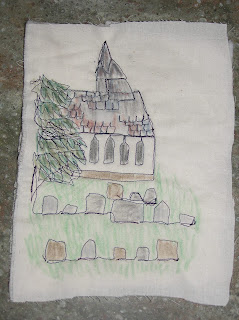One of my all-time favorite books as a youngster was
Anno’s
Journey by Mitsumasa Anno (original U.S. edition, William Collins
Publishers, 1978). As much as I loved to
read from an early age,
Anno’s Journey has no text, only ink and
watercolor landscapes that trace a traveler’s path across Europe of an
undetermined historic time. Anno’s
drawings consist of very simple ink outlines, augmented by watercolor wash. (Take a look at examples
here and
here.) They are simple and complex all at the same
time. His buildings are a delight of
textures, while his people and animals are outlines unencumbered by shading for
depth. There really isn’t room for too
much detail in his figures, as they are very small in his vast land and
cityscapes. The color in his illustrations
is typically understated –mostly muted tones.
Image copyright RPS. Please do not copy or repost
My first attempt at a free motion drawing inspired by Anno.
As a child, I missed Anno’s Flea Market (first U.S.
edition Philomel Books, 1984), but I have been studying a copy of it, and I
think I love it more than the Journey.
Another wordless tale, this flea market unfolds over the pages, set
within the walls of a medieval fort/city/castle. The place and time that this flea market
takes place is ambiguous, and the ages of the items don’t give any clues, nor
does the dress of the people in the market.
What I find most fascinating in Anno’s drawings of the flea market is
the way he ignores perspective and scale to show the viewer all that is
happening. The vendors’ table tops are
tilted to nearly vertical so that Anno’s economical line drawings of the items
may be viewed. The items themselves are
drawn out of scale; hand tools as tall as the people, garlic bulbs as big as
the figures’ heads, and so on. The
skewed scale and perspective really doesn’t matter here, as there is so much
going on in his story illustrations.
Here and there, you will find somewhat sinister things going on at this
flea market – a man with a trumpet on his head, an artist painting a busty
rendition of a flat chested model, and Kermit the Frog makes an unexpected
appearance!

Image copyright RPS. Please do not copy or repost
The same quilted piece from above, with colored pencil added.
Next time, I would add a stabilizer under the top fabric.
Colored pencil does not adhere well to stretchy fabric.
What I take as an art quilter from Anno is his use of line,
his mastery of storytelling without words, and his inclusion of unexpected
surprises. After looking at these two books,
some free motion quilting exercises came to mind. First, try “drawing” outlines of everyday
objects by free motioning. This is a
great way to improve you hand-eye coordination.
Next, try creating a simple line landscape with a building in it. How can you add texture to the land and
structure with stitching? Finally, what
little details could you add to your art that would surprise the viewer? What can you add that would make the viewer
look longer at the piece?
